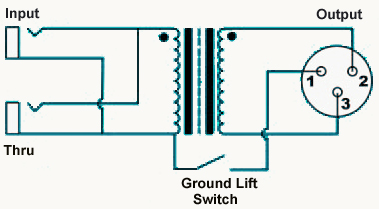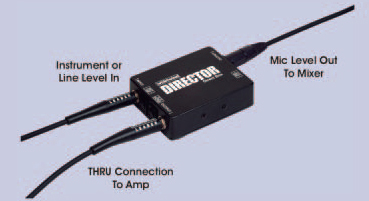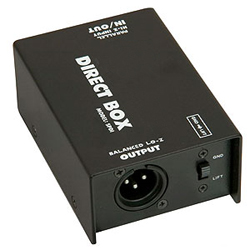Direct boxes are often referred to as “DI boxes” (DI is short for Direct Injection) boxes.
Their primary purpose is to convert unbalanced and/or high-impedance instrument signals into a format suitable for direct connection to a mixing console’s microphone input – without the use of a mic.
DI boxes also can provide several other basic functions:
• Convert a high-impedance signal to a low-impedance signal (although they will also accept a low-impedance signal from a preamplifier, keyboard, active pickup or other electronic device).
• Convert unbalanced signal to balanced.
• Reduce a strong instrument or line-level signal (and sometimes even loudspeaker level signal) to a microphone-level signal suitable for connection to the mic input of a mixing console.
• Isolate electronic equipment on stage from the mixing console, which can help eliminate interference and noise caused by electrical interaction or ground loops.
Passive
The simplest form of DI is termed “passive,” consisting of a box containing a transformer. (see Figure 1)
A high-quality transformer is critical for preserving the frequency characteristics of the signal.

The input connection is usually an unbalanced 1.4-inch guitar-type tip/sleeve jack, and usually two jacks are wired in parallel.
These dual jacks allow an instrument to be connected into the DI and then out again in parallel.
This could be used, for example, in a bass guitar setup where the bass is fed first to the DI and then back out to a bass guitar amplifier located on stage for monitoring. (see Figure 2, below)
Usually the primary (or input) side of the DI will offer an impedance of approximately 20 kOhms, while the secondary (or output side) will have an impedance of about 150 Ohms.

It’s this step-down characteristic of the transformer that reduces the level of the signal to mic level.
The high impedance of the primary side also presents a proper load for various source signals, whether from a high-impedance guitar pickup or low-impedance output from a keyboard, preamplifier or other active device. This helps preserve the frequency response of the input signal.
The secondary side of the transformer converts the signal to balanced and low-impedance, making it suitable for transmitting long distances to a mixing console.
The output connection is usually made via a male three-pin XLR connector, and the ground connected from the input jack’s shield to pin 1 of the XLR is made through a switch on the DI.
This switch provides the ability to break the ground connection between the input and the output.
Ground Lift?
A guitar with passive pickups and its cable shield get a ground connection from the mixing board through the DI’s ground lift switch.




















